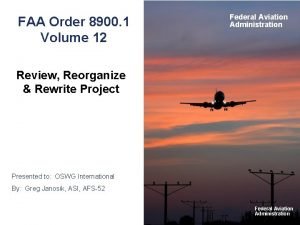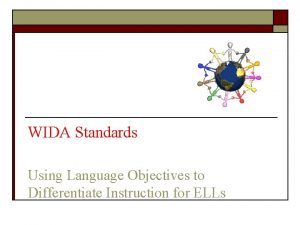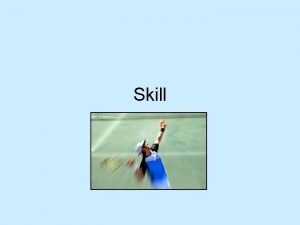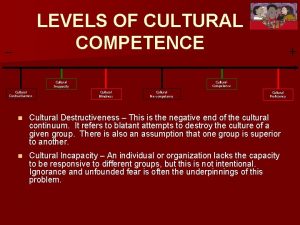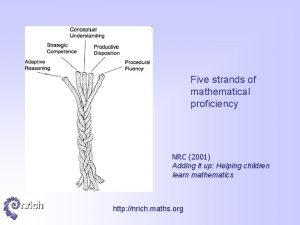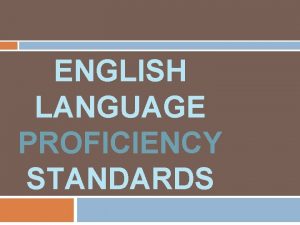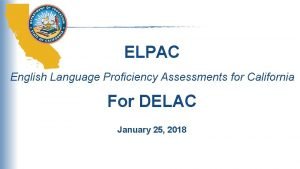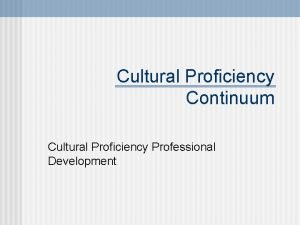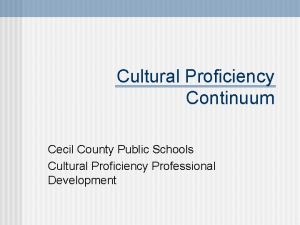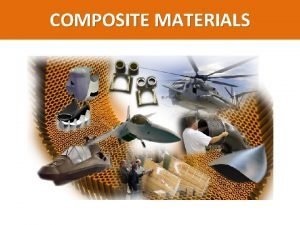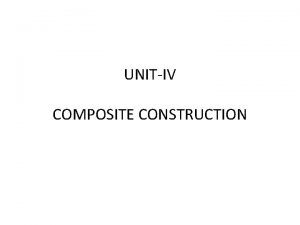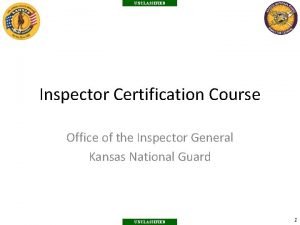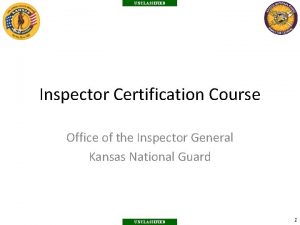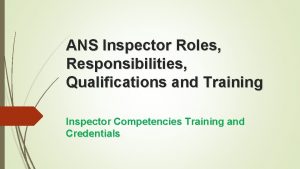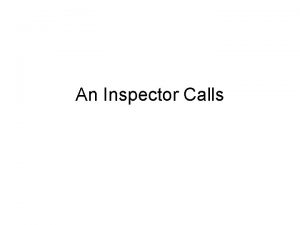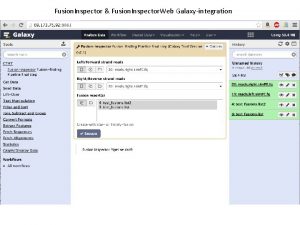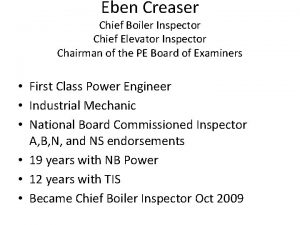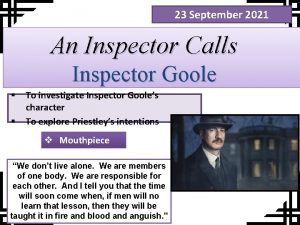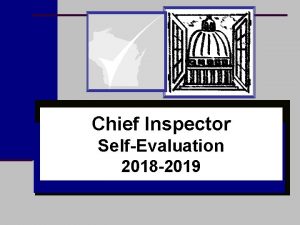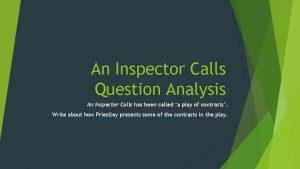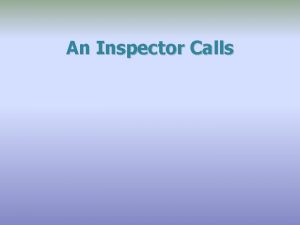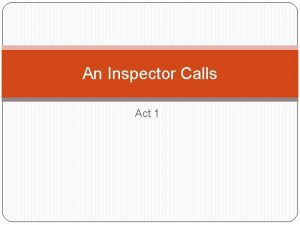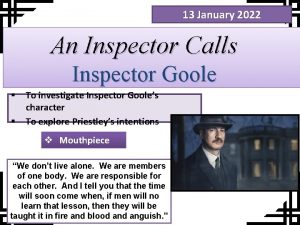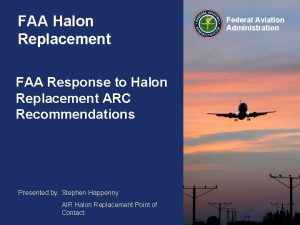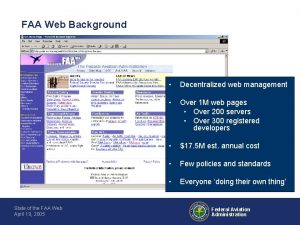FAA Composite Inspector Training Course to Enhance Proficiency





























- Slides: 29

FAA Composite Inspector Training Course to Enhance Proficiency and Improve Reliability Airlines for America NDT – September 2015 Filament Diameters David Westlund, Rusty Jones FAA Stephen Neidigk, Dennis Roach, Tom Rice, Randy Duvall Sandia National Labs FAA Airworthiness Assurance Center

Presentation Overview Introduction and Background POD Experiment Motivation Class Modules and Objectives NDI Proficiency Specimen Set Industry Workshop Path Forward

Motivation for Composite NDI Training Class Motivation - Extensive/increasing use of solid laminate composites on commercial aircraft and need for inspectors to maintain a level of proficiency via training and hands-on practice. Composite Structures on Boeing 787 Aircraft Carbon laminate Carbon sandwich Fiberglass Aluminum/steel/titanium pylons Airbus A 350 XWB altairenlighten. com

Solid Laminate Flaw Detection Experiment Implementation Probability of Detection (POD) Experiment PODs calculated for overall laminate, by thickness family, by substructure effects, by complex geometry effects, by flaw types, etc.

Specimen Set - Flaw Detection in Solid Laminate Composites Thickness Range: 12 – 64 plies Simple Tapers Complex tapers Substructure Flaws Curved Surfaces Array of flaw types NDI Ref. Stds.

POD Curves for 12 -20 Ply Solid Laminate Family Individual and Cumulative Comparisons Overall: POD[90/95] = 1. 29” dia. Probability of Detection Constant Thickness (12, 20, 28 plies): POD[90/95] = 0. 86” dia. Complex Geometry (tapered, curved, substructure, fasteners, honeycomb): POD[90/95] = 1. 49” dia. Flaw Size (Diameter in Inches) False Calls: Constant thickness = 0. 4/inspector Complex Geometry = 4. 0/inspector 34 ft. 2 inspection area

Recommendations – How to move inspections from “average” to “good” to “outstanding” • Increased exposure to representative composite inspections – common industry NDI Proficiency Specimens • • Increased, focused composite NDI training • Enhanced NDI procedures – deployment, signal interpretation, clear schematics showing structural configuration • • • Use of NDI and composite shop apprenticeships (OJT, awareness training, formal/uniform use of this tool) • Follow procedures Use of inspection coverage aids should be required Divide large area inspections into a number of smaller regions Reiteration of best practices & use of NDI apprenticeships Guidance on addressing complex geometry challenges Prepare additional industry guidance to address training, use of NDI Reference and Proficiency specimens, procedures, composite construction awareness

Survey of Industry Composite NDI Training Airline and MRO NDI Survey Only 25% of responders currently have special composite NDI training in place

Question 15 - If experience level is a factor in determining qualification to perform certain inspections, do you use some sort of apprentice program to expose newer inspectors to such inspections? Question 5 – Do inspectors also receive general composite training to understand composite materials, plies, lay-ups, scarfed repairs, composite design, composite processing, etc. ?

Composite NDI Training Class - Drivers • Extensive/increasing use of composites on commercial aircraft • Solid Laminate Flaw Detection Experiment (Probability of Detection) produced recommendations for improving the performance of current inspection practices – key recommendation was to enhance an inspector’s training • NDI Survey– support for additional guidance and training • Identified need for specific training that specifically addresses composite inspection • Unique challenges associated with composites • Additional routine exposure to composite laminate inspections

Composite Laminate NDI Training Class Definition – General Training Content • Summary of typical structural configurations from NDI perspective schematics showing structural configuration • Present NDI challenges and means to address them • Field issues –NDI common errors; human factors concerns, deployment, lessons learned • Inspection cases – typical and unique (unexpected) demands; review of inspection processes and issues/problems from the field (input from operators) • Use of NDI Proficiency Specimens - usage processes/modes for feedback & learning • Hands-on portion of class – designed exercises, selection of equipment, highlight lessons learned with lab exercises

Composite Laminate NDI Training Class Definition – General Training Content (cont. ) • Target Class Length – 2 days (1/2 classroom, 1/2 hands-on) • Format – stand-alone course but assumption is min of Level I student • Instructor modifies for specific needs Goal of training is to enhance aircraft safety & optimize aircraft utilization by improving NDI flaw detection performance in composite aircraft structure.

Composite Laminate NDI Training Class Modules 1. Introduction, Motivation, Objectives & Expected Outcome from Class 2. Composite Awareness – Materials, Design, Fabrication and Use 3. Composite NDI – Theory and Practice 4. Special Cases - Challenges & Lessons Learned 5. NDI Proficiency Specimens 6. Composite NDI – Hands-On Exercises

2. Composite Awareness – Materials, Design, Fabrication and Use What are Composites? Common Materials used Types of Damage Autoclave and VARTM Processing Introduction to Repairs

3. Composite NDI – Theory and Practice • • Visual inspection of composites Basic ultrasonic inspection theory Ultrasonic deployment and options Ultrasonic equipment set up Mapping damage Ultrasonic signals from normal and damaged structure Solid laminate inspection methods and sample results Transducers and Delay Lines Reference Standards TCG Curves Setting Gates Deployment Options Sample Procedures

3. Composite NDI – Theory and Practice A-Scan, B-Scan, C- Scan “Go” / “No-Go” Devices Sizing Damge Scan Indexing, Tapers and Substructure

3. Composite NDI – Theory and Practice Brief introduction and sample results from: • Various phased array systems • CT Scanning • Dolphi. Cam • Thermography • Roller Probes • Laser. UT • Digital Acoustic Video

4. Special Cases – Challenges & Lessons Learned • • Read and Follow the Procedures Embrace New Technology – It Can Be Helpful Composite Damage Tolerance is Good – NDI will Tell Follow OEM Documentation Accidental Damage from Ground Handling Equipment Lightning Strike Damage

5. NDI Proficiency Specimens Initial design guidelines were assembled at the 1 st (August 2014) project kick-off meeting with industry partners and the FAA. • Thickness, materials, flaw types, structural configurations etc. Development Considerations: • Support hands-on training exercises • Support recurrent training and composite NDI exposure • Can be used in “blind mode” to demonstrate inspector proficiency • Multiple flaw profiles and configurations designed so that end users can put together a set that fits their specific training and budget needs • All lessons and teaching points will be encompassed in a limited number of panel configurations (minimize cost) • Specimen geometry designed for ease of construction

5. NDI Proficiency Specimens Panel Configuration Summary - 10 total panels • 3 variations of configuration 1 panel • 2 variations of configuration 2 panel • 3 configuration 3 panels • 2 repair panels Configuration 1 Configuration 2 Configuration 3 Flat solid laminate skin Repair Panel Configuration

5. NDI Proficiency Specimens Example Engineered Flaws in Proficiency Specimens Embedded in the panels Pillow insert *Delamination Grease *Contamination Paper Backing in the bond line *Foreign object damage Paper backing in the laminate *Foreign object damage Carbospheres *Localized porosity Grafoil insert *Tight delamination Pillow insert in the bond line *Disbond

5. NDI Proficiency Specimens Example Engineered Flaws in Proficiency Specimens Added to the panels after fabrication Concentric flat bottom holes *Impact damage Missing Sealant Flat bottom holes *Significant delamination Grinder Cut *Cracked or broken substructure Grinder Disk Grove *Gouge or deep scratch Sealant *Raised material, not a flaw

5. NDI Proficiency Specimens Specimen Design 1 c – Flaw Profile Structure: Thick Specimen - Taper (10: 1 and 20: 1) and secondary bond 32 Ply main skin 32 Ply bonded strips 64 Ply max thickness Fabrication support from NORDAM Interiors and Structures Darryl Graham and Jeff Harper

5. NDI Proficiency Specimens Omni. Scan 3. 5 L 64 (3. 5 MHz) Amplitude Thickness: 0. 240 -0. 480” 64 Ply Specimen 1 c - Inspection TOF Note: Images post processed in Tomo. View analysis. Some flaws didn’t show until further analysis as shown with a red circle.

5. NDI Proficiency Specimens Configuration Design 2 – Description Continued Structure: Uniform thickness skin, pads, fastened shear tie flanges, co-cured stiffeners, sealant 18” Built-up pad section (8 plies) Sound damper (acoustic tiles) 16 Ply thick skin Co-cured stiffener flanges (8 plies) Shear tie flange 24” Sealant between flange and pad Fastened shear tie flange

5. NDI Proficiency Specimens Specimen Design 2 a – Flaw Profile

5. NDI Proficiency Specimens Configuration Design 2 a – Inspection Results Structure: Uniform thickness skin, pads, fastened shear tie flanges, co-cured stiffeners, sealant Omni. Scan 3. 5 L 64 (3. 5 MHz) Back Amplitude TOF

Industry Review Workshop – August 2015 • Presented class materials from the Composite Inspector Training course at an industry review workshop hosted by the AANC at Delta Air Lines maintenance depot in Atlanta. • The prototype class and proficiency specimens were presented. • 35 participants representing airlines, cargo carriers, MROs, aircraft manufacturers and regulators from as far as Japan, Germany and Holland participated in the review of course materials.

Update and Path Forward • • • Complete course module development by end of FY 16 Finish Proficiency Specimen fabrication in collaboration with NORDAM Develop additional, specific hands-on exercises using the proficiency specimens Conduct “dry run” of class with an airline Work with the FAA to determine best methods for course content dissemination to airlines • Complete course description - SAE Aerospace Information Report (AIR) • Adoption and modification by Airlines, MRO’s • Possible course deployment by 3 rd party agency Questions? Stephen Neidigk sneidig@sandia. gov
 The wings pilot proficiency program is based on
The wings pilot proficiency program is based on Douglas fir elastic modulus
Douglas fir elastic modulus 8900 faa
8900 faa Grammar to enrich and enhance writing
Grammar to enrich and enhance writing Define fashion merchandising
Define fashion merchandising Enhance an image
Enhance an image Cspnet
Cspnet Cosmetics are substances that are used to enhance
Cosmetics are substances that are used to enhance Enhance an image
Enhance an image Nanyang jc subject combination
Nanyang jc subject combination Enhance life
Enhance life A salad that stimulates appetite
A salad that stimulates appetite Nnn hypno
Nnn hypno Sailor course brick
Sailor course brick Course title and course number
Course title and course number Course interne moyenne externe
Course interne moyenne externe Language objective differentiation for proficiency levels
Language objective differentiation for proficiency levels Cummins common underlying proficiency
Cummins common underlying proficiency Characteristics of skill
Characteristics of skill Levels of cultural competence
Levels of cultural competence Api proficiency
Api proficiency Morale, proficiency, discipline, and esprit de corps are
Morale, proficiency, discipline, and esprit de corps are Actfl proficiency pyramid
Actfl proficiency pyramid Five strands of mathematical proficiency
Five strands of mathematical proficiency Language competency level
Language competency level Tamu elpe
Tamu elpe Elpac levels meaning
Elpac levels meaning Proficiency level meaning
Proficiency level meaning Cultural proficiency continuum examples
Cultural proficiency continuum examples Cultural destructiveness examples
Cultural destructiveness examples


